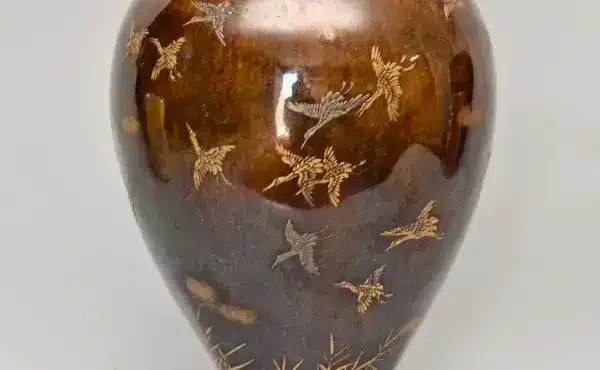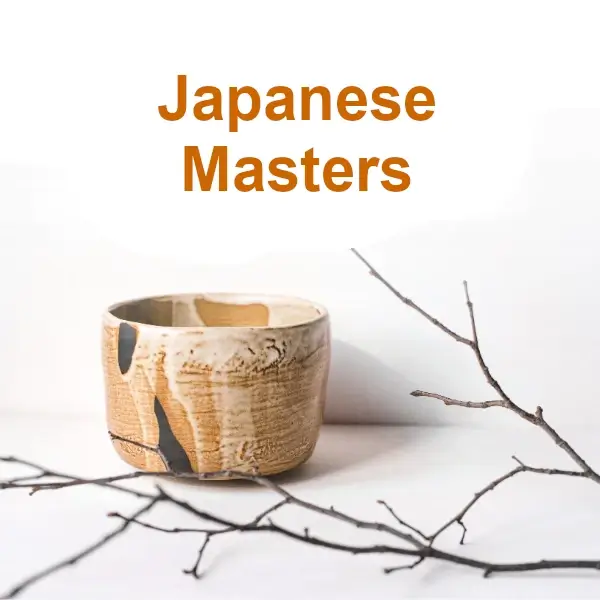The history of ceramics in Japan
The history of Japanese ceramics is rich and varied, spanning multiple periods and styles, each marked by master potters who left an indelible mark on the art. From the ancient forms of Jomon ware to the sophisticated porcelains of the Edo era, Japanese master potters have pioneered techniques and styles that have influenced ceramics worldwide.
Its early history is more obscure than that of China, with the earliest Japanese pottery dating from the Jōmon period (ca. 10,500-300 BC), followed by the better quality, Korean-influenced Yayoi ware until the 6th century AD. During the Asuka or Sueki and Nara periods, there were significant advances in ceramic technique, with influences from Korea and Tang China, although there was a decline at the end of the Heian period.
Hand modeling was maintained even after the lathe became known, and asymmetries and irregularities were intentionally sought. In glazing, similar effects were encouraged: colored glazes were allowed to drip and applied unevenly, often thick, bubbly and with a semi-liquid or honeyed appearance.
Crackled and deeply fissured glazes, known as dragon or lizard skin, were deliberately induced. The painted decoration, often in blue, brown or iron red, was usually summary and almost calligraphic in its simplicity, seeking an overall effect reminiscent of natural objects such as stones, in its apparent lack of artifice.
The best works in Japanese ceramics
From the 15th century, the art of ceramics was also influenced by the elaborate tea ceremony (chanoyu), probably introduced from China by Zen priests, but which acquired a fixed ceremonial pattern at the court of the shogun Yoshimasa in Kyoto. The ceremony, possibly originally used as a means of settling feudal disputes, is held in a hall or pavilion surrounded by a carefully designed garden.
Tea utensils, often antique, are carefully selected by the tea master, and their discussion and appreciation after drinking is valued. Tea masters, being aesthetic arbiters, had a profound influence on the history of pottery in Japan.
The different periods in the history of ceramics in Japan
Jomon Period (c. 14,000 BC – 300 BC): This is one of the earliest periods in the history of Japanese ceramics, known for its pottery forms decorated with impressions reminiscent of coiled ropes. Jomon ware is valued for its primitive character and organic designs.
Yayoi Period (c. 300 B.C. – A.D. 300): Succeeded by the Jomon period, the Yayoi period introduced simpler style pottery, often undecorated or with minimal patterns. This period laid the foundation for future innovations.
Kofun Period (300 – 538 AD): Famous for its “haniwa”, terracotta figures used for ritual and funerary purposes. These figures offer valuable insight into the cultural and artistic practices of the time.
Heian Period (794 – 1185 AD): This period saw the introduction of the three-color (Sancai) glaze technique from China, although official kilns were limited to producing simple green glazes for temples.
Kamakura and Muromachi periods (1185 – 1573 AD): These periods witnessed the popularity of unglazed pottery for everyday use. The “Six Ancient Kilns” (Shigaraki, Tamba, Bizen, Tokoname, Echizen and Seto) were established and improved their techniques and became known for their distinctive ceramics.
Azuchi-Momoyama Period (1573 – 1603 AD): During this time, Japan imported a large amount of Chinese ceramics, including celadon, white porcelain, and blue and white ware. Japanese master potters began to create their own versions of these imports, giving rise to unique Japanese styles such as Ki-Seto, Shino, Seto-Guro and Oribe.
Edo Period (1603 – 1868 AD): A period of peace and prosperity that led to a cultural and economic renaissance. The ceramic industry benefited greatly from the influence of Korean potters, the use of new materials and techniques, and the creation of new kilns.
Each of these periods has been marked by master ceramicists whose work has not only enriched Japanese cultural heritage, but has also influenced ceramic art throughout the world. The techniques and styles developed throughout these periods continue to inspire contemporary ceramists, both in Japan and internationally.
We hope you liked this post. It will help us if you share it on social networks .
Exploring the Ceramic Magic of Yoshimichi Fujimoto: A Visual Journey
Hajime Katō: A Mind-Blowing Journey into Modern Japanese Art



